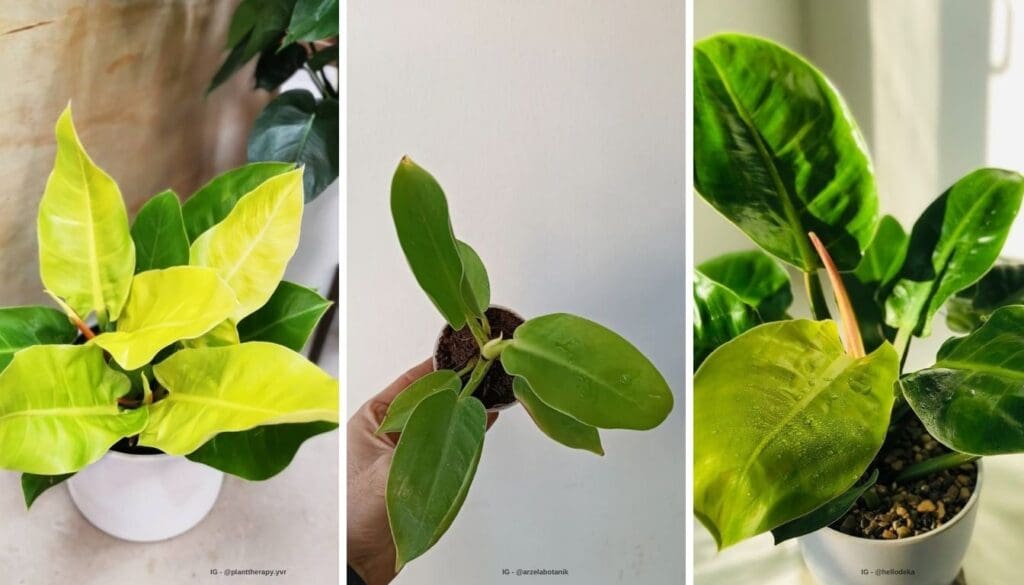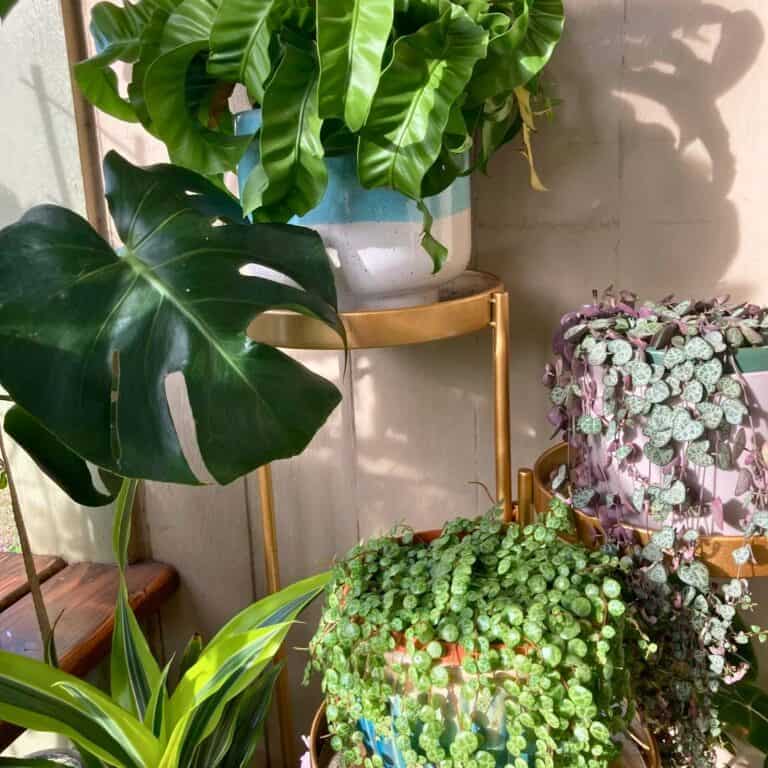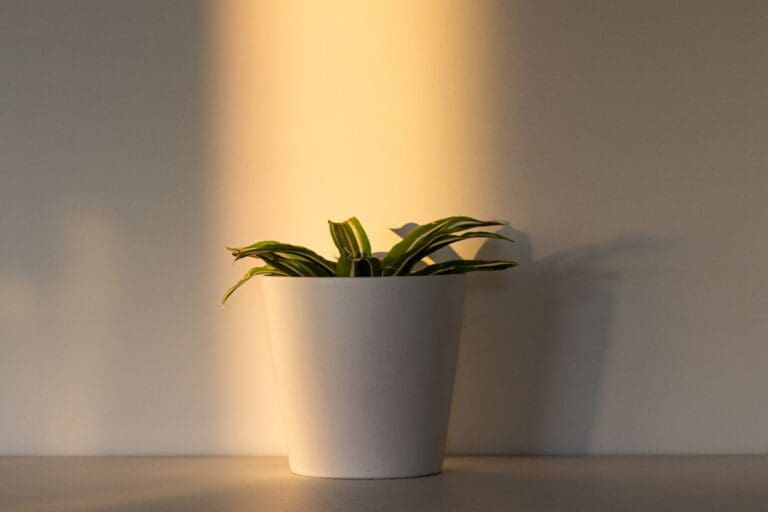Philodendron Moonlight Care Guide: Tips for Thriving Plants
If you’re like me and love having vibrant green plants around, the Philodendron Moonlight is a must-have for your indoor jungle. 🌿
With its bright, lime-green leaves, this plant adds a pop of color and life to any room.
Caring for a Philodendron Moonlight is pretty straightforward.
It thrives in bright, indirect light and should be watered moderately, allowing the top inch of soil to dry out between waterings.
Keeping it away from direct sunlight helps prevent its leaves from fading.
Want to make sure your plant is happy and healthy?
Try placing it near a window with a sheer curtain.
During the growing season, a balanced, water-soluble fertilizer works wonders.
Have you ever tried giving your plant some plant food? 🌱 Let me know in the comments!

Please note: Simplify Plants is reader-supported. As an Amazon Associate, I earn from qualifying purchases made by our readers with no extra cost added to you all! Some links in the post are affiliate links and I get a commission from purchases made through links in the post.
Understanding Philodendron Moonlight
Philodendron ‘Moonlight’ is a stunning, easy-to-care-for houseplant with vibrant foliage that can brighten any room. Let’s dive into the details of this beautiful plant’s species and its unique characteristics.
Species Overview
Philodendron ‘Moonlight’ belongs to the Araceae family, which includes many popular houseplants.
Originating from the tropical regions of South America, this particular species thrives in warm, humid environments.
It’s a hybrid variety, specifically bred for its bright, neon-green leaves.
Unlike vining philodendrons, ‘Moonlight’ is a self-heading plant, meaning it grows in a bush-like formation.
Keeping this plant healthy is quite straightforward.
It prefers bright, indirect light but can adapt to lower light conditions.
Ensure the temperature stays between 65-80°F (18-27°C), and maintain consistent moisture without overwatering.
Characteristics of ‘Moonlight’
The most striking feature of Philodendron ‘Moonlight’ is its vibrant foliage. The leaves start as a lime-green color and mature into a deeper green, creating a beautiful contrast.
The leaves can grow quite large, reaching up to 20 inches in length. This makes it a focal point in any indoor garden.
I love how resilient it is. If you forget to water it occasionally (we’ve all been there!), it’s pretty forgiving.
Just be sure not to let it sit in waterlogged soil, as this can lead to root rot.
This plant also helps purify the air, so it’s not just a pretty face! 🌿✨ Have you added one to your collection yet? Share your experience with me in the comments below! 😃
Fundamentals of Care

Taking care of your Philodendron Moonlight can be easy and rewarding.
Just follow these key points to ensure your plant thrives and looks stunning in your home. 🌿
Light Requirements
Philodendron Moonlight loves bright, indirect light. Avoid placing it in direct sunlight, which can scorch its leaves.
I found the perfect spot for my plant near a north-facing window. This helps the leaves maintain their striking color without getting burnt.
If you’re wondering whether your plant is getting enough light, just look at its leaves. If the color fades, it may need more light.😊
Watering Practices
When it comes to watering, moderation is key.
Overwatering can lead to root rot, which is a common mistake.
I water my Philodendron Moonlight when the top inch of the soil is dry. Use your finger to feel the soil; if it’s dry, add water.
During warmer months, you might need to water more frequently. 💧
Soil Composition
The soil needs to be well-draining.
I use a mix of potting soil, perlite, and orchid bark. This blend ensures the plant’s roots have both air and moisture. Here’s a simple recipe:
- 1 part potting soil
- 1 part perlite
- 1 part orchid bark
Repotting annually helps accommodate its rapid growth. 🪴
Temperature and Humidity
Your Philodendron Moonlight prefers temperatures between 65-80°F (18-27°C).
Keep it away from drafts and sudden temperature changes.
I also like to maintain moderate humidity levels, around 60%.
Using a humidifier or placing a tray of water near the plant works wonders.
If you notice the leaf tips turning brown, it might be too dry. 🌡️
Do these tips match your experience? Let me know in the comments below! 🌟
Plant Nutrition

Taking care of your Philodendron Moonlight means providing the right nutrients for healthy growth and vibrant leaves. Let’s dive into how to keep your plant happy and thriving. 🌿
Fertilizing Schedule
A good fertilizing schedule is key.
During the growing season, which is spring and summer, I fertilize my Philodendron Moonlight once a month.
I use a balanced, water-soluble fertilizer like 20-20-20 or 10-10-10.
You just mix the fertilizer with water according to the package instructions and water the plant as usual.
Remember, more isn’t always better! Too much fertilizer can damage the plant.
A little consistency goes a long way to keep those leaves shining bright.
Signs of Nutrient Deficiency
Nutrient deficiencies can sneak up on your plant.
Yellowing leaves could mean a lack of nitrogen. Brown leaf edges? That might be a potassium issue.
Does your plant look pale and sluggish? It could be missing some magnesium.
Keep an eye out for these signs and adjust the fertilizer if you notice them.
It’s a bit like listening to your plant – it will tell you what it needs if you pay attention.
Plus, it’s super rewarding to see your Philodendron Moonlight looking lush and lively! 🌱
Got questions or tips? Share them in the comments below! Let’s help each other keep our plants happy and healthy. 💬
Growth and Pruning

Philodendron Moonlight is a stunning plant with vibrant, light-green leaves. Knowing how it grows and the right way to prune it is key to keeping it healthy and beautiful.
Growth Expectations
Philodendron Moonlight is a fast grower, perfect for those who love to see quick results. 🌱
It typically reaches a height of about 1.5 to 2 feet indoors. The leaves can grow up to 8 inches long, with a striking, almost neon-green color.
This plant thrives in bright, indirect light and prefers temperatures between 65-80°F (18-27°C).
It doesn’t like direct sunlight—it can burn the leaves.
Keep the soil consistently moist but not waterlogged.
Overwatering can lead to root rot, so be careful! ⛔
Remember, a happy Philodendron Moonlight will produce new leaves regularly.
Pruning Techniques
Pruning your Philodendron Moonlight is simple and rewarding. ✂️
Always use clean and sharp tools to make precise cuts. This helps prevent damage and disease.
The best time to prune is in the spring or summer, when the plant is actively growing.
When you prune, cut just above a leaf node to encourage new growth.
If the plant is becoming too tall or leggy, remove older leaves and stems to promote a fuller appearance.
Don’t be afraid to snip away!
Pruning not only controls the size but also stimulates new growth, keeping the plant lush and vibrant.
Got any tips or questions about your Philodendron Moonlight? Share them in the comments below! 😊🌿
Propagation Methods

When it comes to propagating Philodendron Moonlight, there are two main techniques: division and stem cuttings. These methods are simple and effective, allowing you to expand your plant collection with ease. Let’s dive right in!
Division
One of the easiest ways to propagate a Philodendron Moonlight is by division. This method involves splitting an established plant into smaller sections.
To start, gently tip the mother plant out of its pot. Look for any offsets or baby plants growing at the base.
Using your fingers, carefully loosen the root ball without damaging the roots.
Locate an offset with both leaves and roots, then gently pull it away from the main plant.
It’s like finding hidden treasure in your plant! 🌿
Make sure each divided part has its own roots and leaves before planting it in a new pot with fresh soil.
Keep the new divisions in a warm spot, but avoid direct sunlight.
Stem Cuttings
Another great way to propagate is through stem cuttings. This method is straightforward and often yields fast results. Here’s what you need to do:
- Cut a healthy stem with at least two nodes (the small bumps where leaves and roots grow).
- Place the cutting in water or directly in moist soil.
If you go the water route, change the water every few days to keep it fresh.
In about 2-3 weeks, you should see roots forming. Isn’t plant magic the best? 🌱
Once the roots are a couple of inches long, transfer the cutting to soil.
If planting directly in the soil, keep it moist and place the pot in a bright, indirect light.
So, what’s your favorite method? Division or stem cuttings? Share your thoughts or tips in the comments below! ✨
Pests and Diseases

Taking care of a Philodendron Moonlight means dealing with a few pests and diseases. Let me tell you more about what to watch for and how to keep your plant healthy.
Common Pests
Spider Mites are tiny and weave fine webs on the leaves. If you see yellow spots or speckles, it could be spider mites.
I like to use a gentle insecticidal soap to get rid of them.
Also, Mealybugs look like tiny cotton balls on the plant. They suck the sap and can weaken your plant.
A cotton swab dipped in rubbing alcohol works wonders to remove them.
Then, there are Aphids and Scales.
Aphids are small and might gather in groups, and scales can look like tiny bumps on the stems and leaves.
For both, spraying the plant with water and then using neem oil can help.
It’s essential to check your plant regularly for these invaders.
Tip: Giving your plant a regular shower helps keep these pests away!
Disease Prevention
Diseases can be a bit tricky, but I’ve got some tips for you.
First, root rot is common due to overwatering.
Make sure the top inch of soil dries out between waterings. Your Philodendron will thank you.
Also, ensure you’re using well-draining soil and a pot with drainage holes.
Another issue is leaf spot diseases, which show as brown spots on the leaves.
This can be from too much moisture on the leaves or poor air circulation.
Always water the soil directly and not the leaves, and keep your plant in a spot where air can flow freely around it.
Keeping the leaves clean and dust-free also prevents diseases.
Wipe them down with a damp cloth regularly.
If you see any sick leaves, trim them off to avoid spreading. 💡
Always use clean tools when pruning or repotting. A healthy care routine means a happy plant!
Got any tips of your own? Share them in the comments below. 🌱✨
Troubleshooting
Taking care of a Philodendron Moonlight can be fun, but sometimes things go wrong. Below, I’ll help you figure out why your plant might be having issues and what you can do about it. 🌿
Yellowing Leaves
Yellowing leaves on a Philodendron Moonlight can be alarming, but it’s usually a sign of something specific.
Overwatering is the most common cause. If the soil is soggy, it can cause the roots to rot, leading to yellow leaves. 🥺 To fix this, let the soil dry out before you water again.
Underwatering can also cause yellow leaves. If the soil feels dry to the touch, give your plant a good drink. 💧 Just make sure the water drains well, so the roots don’t sit in water.
Sometimes, low humidity or lack of nutrients can cause yellowing.
Boost the humidity by placing a tray of water near the plant or using a humidifier. A balanced, water-soluble fertilizer once a month during the growing season can prevent nutrient deficiencies.
Drooping or Wilting
Drooping or wilting leaves can be a sign of stress.
One big cause is improper watering. Both overwatering and underwatering can make the leaves droop. Make sure you’re striking the right balance. 🏞️
Temperature changes can also affect your plant’s health.
Philodendron Moonlight likes temperatures between 65-80°F (18-27°C). Try to keep it away from drafts or sudden temperature swings.
Another thing to check is lighting.
Too much direct sunlight or too little light can make the leaves wilt. This plant prefers bright, indirect light. If you need to, move it to a spot where it gets better light but not direct sun.
Repotting Philodendron Moonlight

When it’s time to repot your Philodendron Moonlight, it’s like giving it a fresh start! 🪴
First, I check if the plant is root-bound. If I see roots poking out of the drainage holes or circling inside the pot, it’s time for a new home. For most of us, this is every 2-3 years.
I gently remove the plant from its pot. I like to loosen the root ball with my fingers and shake off any old soil.
If your plant has grown offsets (baby plants), carefully separate them. These can be potted up to grow new plants! 🌱
Next, I choose a pot that’s slightly larger than the old one. I avoid pots that are too big because they can hold too much moisture and cause root rot. A pot with drainage holes is a must!
For soil, I use a well-draining mix. A combo of potting soil, perlite, and a little orchid bark works great for me. I place the plant in its new pot, filling in around the roots with fresh soil.
After repotting, I water the plant well, letting the excess water drain out. Then I put it back in its favorite bright, indirect light spot. 🌞
FAQs and Tips
How often should I water my Philodendron Moonlight?
I usually water my Philodendron Moonlight moderately.
It’s best to wait until the top inch or two of soil dries out before the next watering. Overwatering can cause problems, so keep it in check!
What’s the ideal temperature?
Philodendron Moonlight loves a cozy spot. A temperature between 65-80°F (18-27°C) is perfect. Don’t let it stay in direct sunlight or a room that’s too hot.
How do I fertilize it?
I fertilize mine once a month during spring and summer with a balanced, water-soluble fertilizer.
Look for something like a 20-20-20 or 10-10-10 mix.
When should I repot?
These plants grow quickly! I find it best to repot annually to give the roots plenty of space.
Any tips for propagation?
If you’re looking to propagate, gently remove offsets with both leaves and roots.
Place your cuttings in a warm, bright area with indirect light. Keep the soil consistently moist but not soggy. 🌱
How can I avoid pests?
I keep an eye out for common pests like spider mites.
Regularly inspect the underside of leaves and use insecticidal soap if needed. A clean, healthy plant is less attractive to pests.
Conclusion
Taking care of a Philodendron Moonlight isn’t hard at all! 😊
By following a few simple tips, you can keep your plant happy and healthy.
Remember to provide medium to bright indirect light.
Too much direct sunlight can scorch the leaves, while too little light can make the plant leggy.
Stick to a regular watering routine. I usually wait until the top inch of the soil feels dry before watering again.
Make sure the pot has good drainage to avoid root rot.
Don’t forget to use a well-draining soil mix. A mix designed for tropical plants works best.
I also like to fertilize my Philodendron Moonlight every month during the growing season.
Pruning is a simple way to keep the plant looking its best.
Remove any yellow or brown leaves to maintain its vibrant appearance.
Are you seeing pesky pests?
Use a gentle insecticidal soap or simply wipe the leaves with a damp cloth to keep bugs at bay.
Would you like to try propagation? It’s quite fulfilling!
Gently separate offsets from the mother plant and pot them individually.
Give them the same love and care as the parent plant. 🌱
How has your experience been with this plant?
Share your tips and stories in the comments below!
Let’s learn from each other and grow our plant care skills together. 🌿✨
Recommended Garden Supplies
| Product Image | Our Recommended Gardening Supplies | Check Offers! |
|---|---|---|
Top Top
Top
Top
Top
Top
Top
Top
Top | rePotme Houseplant and Tropical Classic Potting Soil Mix | Check Offer On Amazon |
 Top
Top
Top
Top
Top
Top
Top
Top | Espoma Organic Indoor Plant Food | Check Offer On Amazon |
 Top
Top
Top
Top
Top
Top
Top
Top | GooingTop LED Grow Light 6000K Full Spectrum Clip Plant Growing Lamp | Check Offer On Amazon |
 Top
Top
Top
Top
Top
Top
Top
Top | Soil Moisture Meter | Check Offer On Amazon |
 Top
Top
Top
Top
Top
Top
Top
Top | Govee Hygrometer Thermometer, Bluetooth Enabled! | Check Offer On Amazon |
 Top
Top | LEVOIT Humidifiers for Large Room(Best For Plants) | Check Offer On Amazon |
 Top
Top
Top
Top
Top
Top
Top
Top | Upgraded DIY Automatic Drip Irrigation Kit, 15 Potted Houseplants Support | Check Offer On Amazon |
 Top
Top
Top
Top
Top
Top
Top
Top | Stainless Steel Heavy Duty Gardening Tool Set | Check Offer On Amazon |
 Top
Top
Top
Top
Top
Top
Top
Top | Bonide Insecticidal Soap | Check Offer On Amazon |
 Top
Top
Top
Top
Top
Top
Top
Top | Bonide 32 oz Spray Neem Oil for Organic Gardening | Check Offer On Amazon |
 Top
Top
Top
Top
Top
Top
Top
Top | Garden Safe Fungicide | Check Offer On Amazon |





